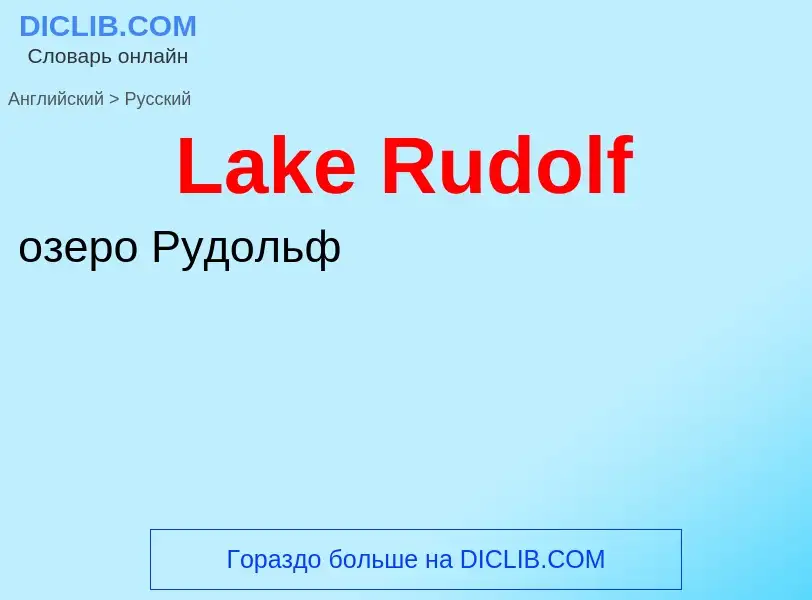Translation and analysis of words by ChatGPT artificial intelligence
On this page you can get a detailed analysis of a word or phrase, produced by the best artificial intelligence technology to date:
- how the word is used
- frequency of use
- it is used more often in oral or written speech
- word translation options
- usage examples (several phrases with translation)
- etymology
Lake Rudolf - translation to russian
Definition
Wikipedia

Lake Turkana (, Rendille: Bad "Ocean"), formerly known as Lake Rudolf, is a lake in the Kenyan Rift Valley, in northern Kenya, with its far northern end crossing into Ethiopia. It is the world's largest permanent desert lake and the world's largest alkaline lake. By volume it is the world's fourth-largest salt lake after the Caspian Sea, Issyk-Kul, and Lake Van (passing the shrinking South Aral Sea), and among all lakes it ranks 24th.
Lake Turkana is now threatened by the construction of Gilgel Gibe III Dam in Ethiopia due to the damming of the Omo river which supplies most of the lake's water.
Although the lake commonly has been —and to some degree still is— used for drinking water, its salinity (slightly brackish) and very high levels of fluoride (much higher than in fluoridated water) generally make it unsuitable, and it has also been a source of diseases spread by contaminated water. Increasingly, communities on the lake's shores rely on underground springs for drinking water. The same characteristics that make it unsuitable for drinking limits its use in irrigation. The climate is hot and very dry.
The rocks of the surrounding area are predominantly volcanic. Central Island is an active volcano, emitting vapour. Outcrops and rocky shores are found on the east and south shores of the lake, while dunes, spits and flats are on the west and north, at a lower elevation.
On-shore and off-shore winds can be extremely strong, as the lake warms and cools more slowly than the land. Sudden, violent storms are frequent. Three rivers (the Omo, Turkwel and Kerio) flow into the lake, but lacking outflow, its only water loss is by evaporation. Lake volume and dimensions are variable. For example, its level fell by 10 m (33 ft) between 1975 and 1993. Despite the lack of outflow, in ecology it is often regarded as a part of —or at least associated with— the Nile basin because of its prehistoric connection to this system and the similarities in their aquatic faunas.
Due to temperature (its surface water typically is 27–31 °C [81–88 °F] and the mean air temperature of the region generally is similar or slightly higher), aridity and geographic inaccessibility, the lake retains its wild character. Nile crocodiles are found in great abundance on the flats. The rocky shores are home to scorpions and carpet vipers. The lake is rich in fish and fishing is very important to the local economy, but this is threatened by falling water levels and overfishing.
Lake Turkana National Parks are now listed as a UNESCO World Heritage Site. Sibiloi National Park lies on the lake's eastern shore, while Central Island National Park and South Island National Park lie in the lake. Both are known for their Nile crocodiles.
An abundance of hominid fossils have been discovered in the area surrounding Lake Turkana.
The area still sees few visitors, being two days' drive from Nairobi. The lake is also an imaginary boundary of the Rendille and Borana and Oromo to the Turkana land. The area is primarily clay-based and is more alkaline than seawater.


![View of Lake Turkana with the [[Koobi Fora]] formations in the background. View of Lake Turkana with the [[Koobi Fora]] formations in the background.](https://commons.wikimedia.org/wiki/Special:FilePath/Lake Turkana in Kenya 01.jpg?width=200)


![[[Badwater Basin]] [[dry lake]], 15 February 2007. [[Landsat 5]] satellite photo [[Badwater Basin]] [[dry lake]], 15 February 2007. [[Landsat 5]] satellite photo](https://commons.wikimedia.org/wiki/Special:FilePath/Badwater tm5 2007046.jpg?width=200)

![Lakes can have significant cultural importance. The [[West Lake]] of [[Hangzhou]] has inspired romantic poets throughout the ages, and has been an important influence on garden designs in China, Japan and Korea.<ref>[https://whc.unesco.org/en/news/767 Ancient Chinese cultural landscape, the West Lake of Hangzhou, inscribed on UNESCO's World Heritage List]. UNESCO (24 June 2011)</ref> Lakes can have significant cultural importance. The [[West Lake]] of [[Hangzhou]] has inspired romantic poets throughout the ages, and has been an important influence on garden designs in China, Japan and Korea.<ref>[https://whc.unesco.org/en/news/767 Ancient Chinese cultural landscape, the West Lake of Hangzhou, inscribed on UNESCO's World Heritage List]. UNESCO (24 June 2011)</ref>](https://commons.wikimedia.org/wiki/Special:FilePath/China Hangzhou Westlake-8.jpg?width=200)
![[[Lake Eyre]]'s shape and depth as a gradient map [[Lake Eyre]]'s shape and depth as a gradient map](https://commons.wikimedia.org/wiki/Special:FilePath/Eyre lake map of the shape and depth (bathymetry) 2020.jpg?width=200)
![The crater lake of [[Mount Rinjani]], [[Indonesia]] The crater lake of [[Mount Rinjani]], [[Indonesia]]](https://commons.wikimedia.org/wiki/Special:FilePath/Gunung rinjani.jpg?width=200)
![Ice melting on [[Lake Balaton]] in Hungary Ice melting on [[Lake Balaton]] in Hungary](https://commons.wikimedia.org/wiki/Special:FilePath/Ice Melting on Lake Balaton.jpg?width=200)
![[[Ephemeral]] 'Lake Badwater', a lake only noted after heavy winter and spring rainfall, [[Badwater Basin]], [[Death Valley National Park]], 9 February 2005. [[Landsat 5]] satellite photo [[Ephemeral]] 'Lake Badwater', a lake only noted after heavy winter and spring rainfall, [[Badwater Basin]], [[Death Valley National Park]], 9 February 2005. [[Landsat 5]] satellite photo](https://commons.wikimedia.org/wiki/Special:FilePath/Lake Badwater, Death Valley, 2005.jpg?width=200)
![West Coast]] region of [[New Zealand]]. West Coast]] region of [[New Zealand]].](https://commons.wikimedia.org/wiki/Special:FilePath/Lake Kaniere.jpg?width=200)
![[[Lake Mapourika]], New Zealand [[Lake Mapourika]], New Zealand](https://commons.wikimedia.org/wiki/Special:FilePath/Lake mapourika NZ.jpeg?width=200)
 and algal communities (right).jpg?width=200)
![The [[Nowitna River]] in Alaska. Two oxbow lakes – a short one at the bottom of the picture and a longer, more curved one at the middle-right. The [[Nowitna River]] in Alaska. Two oxbow lakes – a short one at the bottom of the picture and a longer, more curved one at the middle-right.](https://commons.wikimedia.org/wiki/Special:FilePath/Nowitna river.jpg?width=200)
![Cassini]]'' [[synthetic aperture radar]] mosaic Cassini]]'' [[synthetic aperture radar]] mosaic](https://commons.wikimedia.org/wiki/Special:FilePath/PIA10008 Seas and Lakes on Titan.jpg?width=200)
![Five Flower Lake in [[Jiuzhaigou]], [[Sichuan]] Five Flower Lake in [[Jiuzhaigou]], [[Sichuan]]](https://commons.wikimedia.org/wiki/Special:FilePath/九寨溝-五花海 Jiuzhaigou Five Flower Lake.jpg?width=200)
